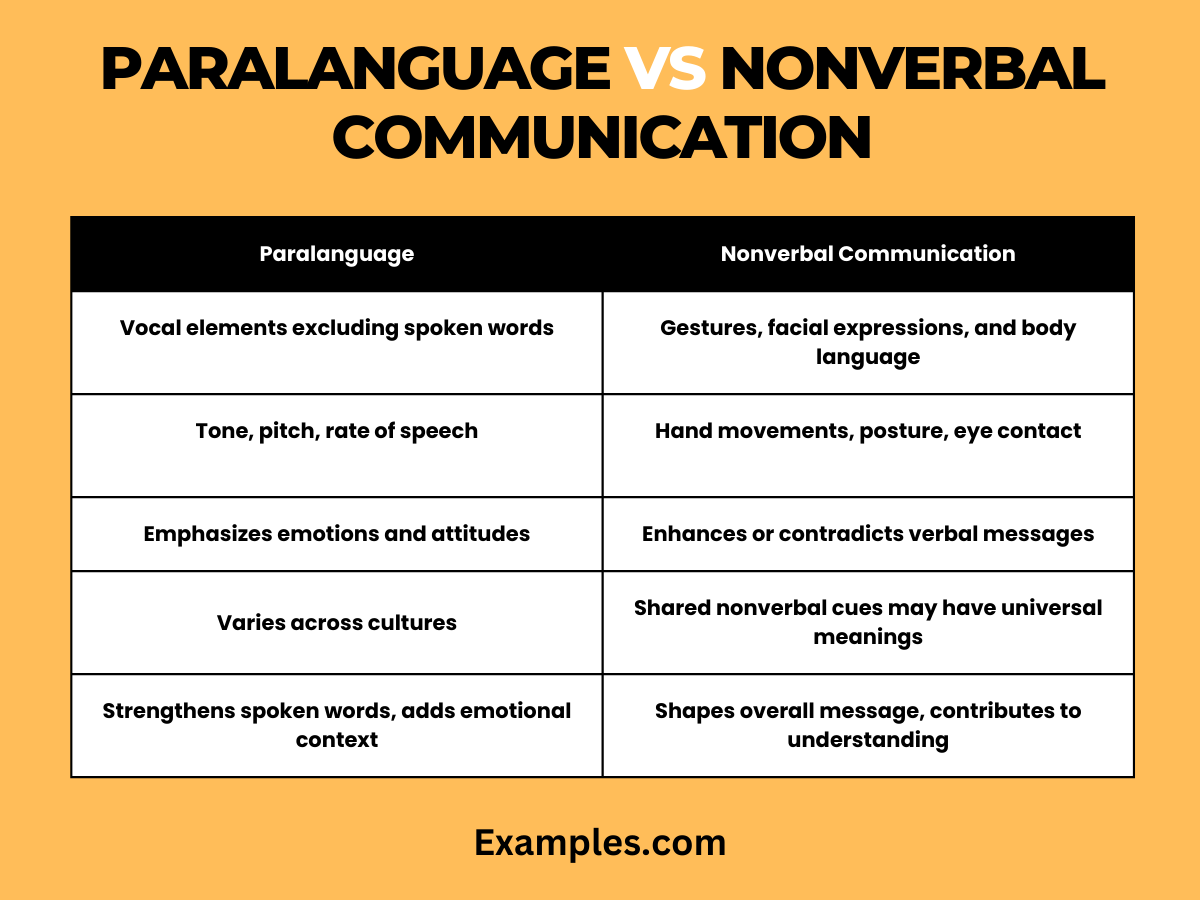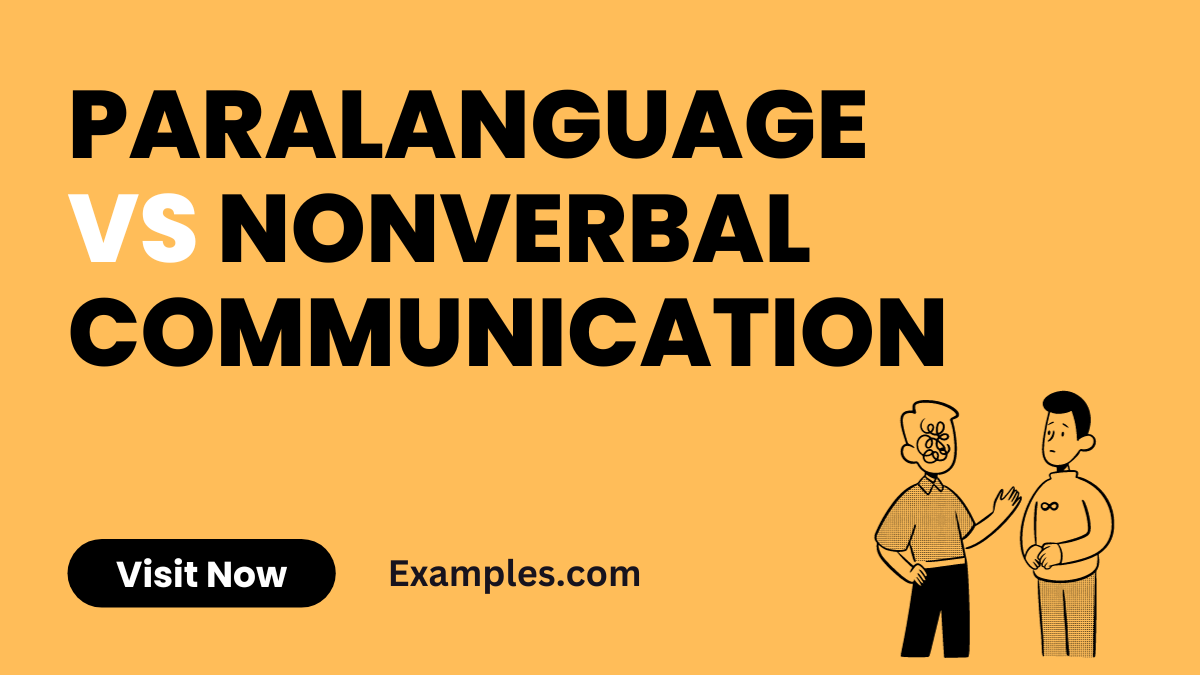Paralanguage vs Nonverbal Communication – 19+ Examples
Embark on a comprehensive journey through our guide on Paralanguage vs. Nonverbal Communication examples. Uncover the nuances of tone, pitch, and body language, delving into the intricacies of effective communication. Gain valuable insights into how these elements intertwine and impact daily interactions. Elevate your communication skills with practical examples and actionable tips, making this your go-to resource for mastering the art of expression. Communication examples abound, providing a rich context for enhanced understanding. Explore the dynamics of effective communication with our insightful guide.
What is the difference between Paralanguage vs Nonverbal Communication?

Understanding Paralanguage: Paralanguage encompasses vocal elements beyond spoken words. Dive into nuances like tone, pitch, and rate of speech. Explore how these subtleties convey emotions, emphasizing the importance of active listening.
Deciphering Nonverbal Communication: Nonverbal cues extend beyond words, incorporating gestures, facial expressions, and body language. Unravel the intricate web of nonverbal signals that influence interpersonal dynamics.
| Aspect | Paralanguage | Nonverbal Communication |
|---|---|---|
| Definition | Vocal elements excluding spoken words | Gestures, facial expressions, and body language |
| Primary Components | Tone, pitch, rate of speech | Hand movements, posture, eye contact |
| Influence on Message | Emphasizes emotions and attitudes | Enhances or contradicts verbal messages |
| Cultural Variations | Varies across cultures | Shared nonverbal cues may have universal meanings |
| Impact on Communication | Strengthens spoken words, adds emotional context | Shapes overall message, contributes to understanding |
Interplay Between Paralanguage and Nonverbal Communication: Explore how these two elements intersect in everyday communication. Understand their collaborative role in conveying meaning and fostering effective connections.
Mastering the Art: Tips for Improved Communication: Discover practical tips for refining both paralanguage and nonverbal communication. Enhance your skills to convey messages more clearly and interpret others with greater accuracy.
10 Paralanguage Communication Examples
Paralanguage, a powerful aspect of communication, goes beyond spoken words. Here are 10 examples that showcase its diverse forms:
- Laughter: Express joy through hearty laughter, a universal paralinguistic signal that transcends language barriers.
- Tone of Voice: A warm and friendly tone fosters connection, while a harsh tone may convey displeasure or criticism.
- Pitch Variation: Modulate pitch to convey enthusiasm, with higher pitches reflecting excitement and lower pitches exuding seriousness.
- Pace of Speech: Adjust speech pace to match the context; speak slowly for emphasis and quickly for casual conversations.
- Silence as Emphasis: Utilize strategic pauses to underscore important points, allowing listeners to absorb and reflect.
- Sighs and Exhalations: Subtle sighs can communicate frustration or contentment, offering additional layers to spoken words.
- Nervous Habits: Nail-biting or fidgeting may reveal anxiety, offering cues about one’s emotional state.
- Intonation Patterns: Varied intonation adds richness to speech, distinguishing between questions, statements, and exclamations.
- Volume Control: Adjust volume to suit the setting, ensuring clarity without overpowering or underplaying the message.
- Speech Rhythm: A rhythmic and flowing speech pattern can captivate listeners, making the communication experience more engaging.
10 Nonverbal Communication Examples
Nonverbal communication, often more impactful than words, encompasses various cues and gestures. Here are 10 examples illustrating its significance:
- Facial Expressions: Your face conveys emotions; a smile communicates warmth, while a furrowed brow signals concern.
- Gestures: Hand movements, like waving or pointing, enhance verbal messages, adding emphasis and clarity.
- Posture and Body Language: An upright posture exudes confidence, while slouched shoulders may suggest fatigue or disinterest.
- Eye Contact: Establishing and maintaining eye contact conveys attentiveness, sincerity, and confidence.
- Touch: Appropriate touch, like a handshake or a pat on the back, communicates warmth, connection, and support.
- Proximity: The distance between individuals reflects the nature of their relationship, from intimate to formal.
- Paralinguistics: Vocal variations, such as tone, pitch, and speed, contribute to nuanced communication.
- Appearance: Clothing and grooming choices communicate professionalism, personal style, and cultural identity.
- Artifacts: Personal items, like jewelry or accessories, can convey aspects of one’s identity or status.
- Environmental Cues: The ambiance of a space influences communication; a well-lit room fosters engagement.
What is the Comparison between Paralanguage vs Nonverbal Communication?
When exploring the realms of communication, it’s crucial to understand the distinctions between paralanguage and nonverbal communication. Below is a detailed comparison presented in a table format, highlighting the key differences between these two essential aspects of human interaction.
| Aspect | Paralanguage | Nonverbal Communication |
|---|---|---|
| Definition | Encompasses vocal cues excluding words. | Includes all communication without spoken language. |
| Components | Tone, pitch, rate, volume, and vocal cues. | Gestures, facial expressions, posture, and proximity. |
| Influence on Message | Enhances or modifies the meaning of words. | Communicates feelings, attitudes, and relational cues. |
| Examples | Tone of voice: Cheerful, sarcastic, etc. | Gestures: Waving, pointing. Facial Expressions: Smiles, frowns. Posture: Upright, slouched. |
| Cultural Variations | Influenced by cultural speech patterns. | Varied across cultures, impacting body language norms. |
| Role in Miscommunication | Tone can convey unintended emotions. | Misinterpreted gestures or facial expressions. |
| Importance in Relationships | Reflects emotions and attitudes. | Builds rapport and understanding beyond spoken words. |
| Adaptability | Can be consciously altered for effect. | Often subconscious, influenced by cultural background. |
| Enhancement of Verbal Communication | Strengthens the emotional impact of spoken words. | Provides additional context and emphasis to verbal messages. |
Understanding the nuances of paralanguage and nonverbal communication is integral to effective interpersonal interactions. While paralanguage adds layers to spoken words, nonverbal cues serve as a silent yet powerful language in themselves, shaping the broader context of communication. It’s the synergy of both that allows for a more comprehensive and nuanced understanding in human connections.
What is the Relationship Between Paralanguage and Nonverbal Communication
Navigating the intricate dynamics between paralanguage and nonverbal communication unveils a rich tapestry of nuances that significantly influence how we convey and interpret messages. This guide delves into the relationship between these two communication forms, offering insights in a structured table format.
Understanding the interconnectedness of paralanguage and nonverbal communication is pivotal for mastering the art of effective expression. Below is a detailed comparison highlighting the relationship between these two facets:
| Criteria | Paralanguage | Nonverbal Communication |
|---|---|---|
| Nature of Communication | Vocal elements accompanying speech. | All communication without the use of words. |
| Elements of Expression | Tone, pitch, speed, volume, pauses. | Body language, facial expressions, gestures, posture, etc. |
| Dependency on Verbal Language | Accompanies verbal language but isn’t the actual words. | Entirely independent of verbal language. |
| Modes of Conveyance | Through speech and vocal expressions. | Via body movements, facial expressions, spatial relations. |
| Cultural Variations | Variations in accents, intonation, and speech patterns. | Varied interpretations of gestures, expressions, and space usage. |
For an in-depth understanding of the nuances between paralanguage and nonverbal communication, it’s beneficial to consult authoritative sources. The National Communication Association’s official website (https://www.natcom.org) offers comprehensive insights and scholarly articles that delve into various aspects of communication, including paralanguage. Additionally, the American Psychological Association (https://www.apa.org) provides valuable resources and research findings on nonverbal communication, helping readers understand the psychological underpinnings of these interactions. For an academic perspective, Harvard University’s resources on communication (https://www.harvard.edu) can offer scholarly articles and studies. These resources are from high-authority, reputable domains, ensuring the information is reliable and relevant to the topic



